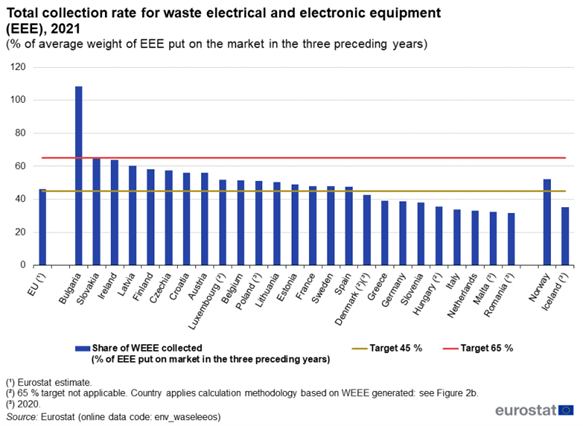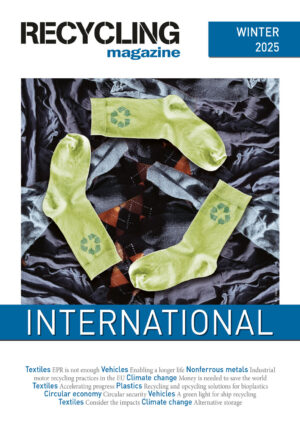Whilst the WEEE Forum acknowledges that much more waste electrical and electronic equipment (WEEE) must be separately collected for responsible management and to recover (critical) materials, we also believe that it highlights the need to thoroughly revise waste legislation.
Under Directive 2012/19/EU on WEEE, the minimum collection rate to be achieved annually by the Member States is set at 65% of the average weight of electrical and electronic equipment placed on the market in the three preceding years in the Member State concerned, or alternatively 85% of WEEE generated on the territory of that Member State. The majority of Member States failed to collect sufficient WEEE separately and therefore missed the EU collection target. The Commission says that “Member States should boost their implementation efforts in order to meet the abovementioned obligations”.
“Whilst it is undeniably true that more WEEE must be separately collected, in view of proper re-use, repair or recycling, and that waste legislation must be adequately implemented and enforced, Member States’ failure in meeting the minimum collection rates underscores the urgency of a thorough rethink of waste legislation and its implementation and the importance of a reform of the Extended Producer Responsibility principle along #allactors principles” says Pascal Leroy, Director General of the WEEE Forum.
Over the past twenty years, PROs have invested millions in measures, chief among them were awareness campaigns and collection infrastructure, driving up not only collection volumes but also collected kilogram per inhabitant. Yet despite all these investments, after more than twenty years of WEEE legislation, Bulgaria and Slovakia are reportedly the only Member States that meet the minimum collection rate of 65% as defined by Directive 2012/19/EU on WEEE – see the Annex of total collection rate in the EU in 2021. The average collection rate in the EU barely exceeds 45%.
During the last few years, the WEEE Forum has consistently argued that the minimum collection rate methodology is not meaningful, and therefore not fit for purpose, for three distinct reasons: it has a perverse effect, it is ill-suited for circularity strategies, and it is distortive.
Perverse
The minimum collection rate has a perverse effect: the more WEEE is disposed of, the easier it is for that Member State to meet the minimum collection rate. Countries where people do not return their end-of-life appliances to a collection point to have them repaired or recycled, but repair them themselves, or give them a second life by sharing them with relatives, will generate a smaller volume of WEEE and therefore show lower collection rates. The EU seeks to promote circularity initiatives, not a pro forma higher collection rate.
Ill-suited for circularity
In an age where we strive to make our economy more circular, the current minimum collection rate fails to measure progress towards circularity in terms of products being reused or products’ lives being extended. The current methodology does not measure reduction of consumption, consumers’ hoarding, and circular consumer behaviour, which would be constituents of a much more powerful set of circularity metrics.
Distortive
The placed-on-market method looks at the preceding three years and does not take account of the full lifecycle of electrical and electronic equipment. Some products, notably photovoltaics and air conditioning equipment, washing machines and refrigerators, have a lifetime of, respectively, minimum 20-25 and 10–15 years. Therefore, the 65% minimum rate based on the preceding three years is meaningless. In the Member States where photovoltaics and other household appliances are clustered in the same product category, that category fails to reach the minimum collection rate due to the long lifespan of photovoltaics, which in turn induces the competent authorities to issue penalties and requiring PROs to collect higher volumes of non-photovoltaic products in order to reach the targeted volumes for photovoltaic panels. Such penalties distort the market and the principle of Extended Producer Responsibility and are therefore unacceptable.
A draft final study supporting the evaluation of Directive 2012/19/EU, authored by a consortium of Ramboll, Umweltbundesamt and Öko-Institut in 2023, came to a similar conclusion: “Current calculation methodology usually applied are incoherent in so far as the long lifespan of some products are not taken into account”.
Call for action
For all the above reasons, the WEEE Forum suggests the following:
A. Revise the Waste Framework and WEEE legislation
Pursuant to the most recent amendment to Directive 2012/19/EU, the impact assessment in view of a revision of the Directive must evaluate, inter alia,
- elements related to the waste hierarchy,
- the obligation not to burden consumers with disproportionate costs,
- provisions ensuring full implementation and enforcement of this Directive, in particular with regard to adequate collection targets,
- measures aimed at preventing illegal trade of WEEE,
- a new ‘photovoltaic panels’ category.
B. Design and develop circularity metrics
The minimum WEEE collection rate methodology must measure all aspects of the circular economy, such as reduction of consumption, the global economy, market trends, consumers’ hoarding, and circular consumer behaviour, which would be constituents of a much more powerful set of circularity metrics. Legislation must identify alternative performance indicators more akin to a circular economy.
C. Evaluate, improve and harmonise Eurostat system of waste statistics
The validity and robustness of the Eurostat system of waste statistics must be made subject to a thorough, critical evaluation and revision, involving consultation of stakeholders.
D. Put the #allactors principle into practice
It takes a village to solve the e-waste problem; e-waste is a societal challenge. The 2023 amendment to the Directive says that “provisions ensuring full implementation and enforcement of this Directive, specifically concerning adequate collection targets, as well as preventing illegal trade of WEEE” must be assessed. The Member States must enforce the legal obligations of all actors and an EU enforcement agency must be empowered to audit the Member States obligations. The #allactors principle, underlining the importance of collective, collaborative action and good governance, must lie at the heart of the revised Extended Producer Responsibility policy approach: all entities that have access to e-waste are subject to minimum legal obligations and actively collaborate towards responsible operations.
E. Integrate EPR waste objectives in the wider framework of materials management
Beyond the Waste Framework legislation, the EU is in need of a policy framework for managing materials through the lens of circularity. We cannot achieve climate goals without becoming more circular. Reducing dependence on materials will contribute to our resilience.











